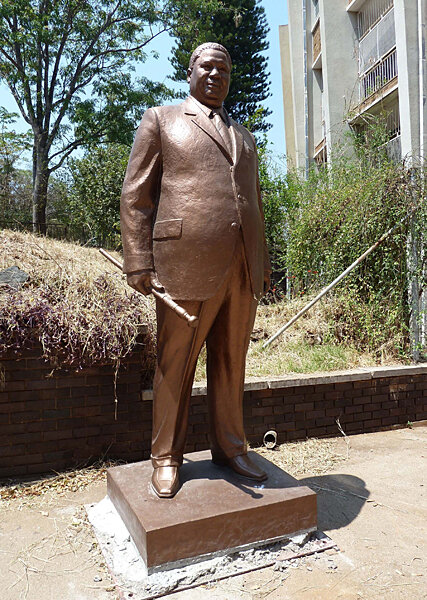How a pair of North Korean-built statues reopened ethnic wounds in Zimbabwe
Loading...
| Johannesburg, South Africa
All great artists have their critics. Ask a group of (apparently nameless) North Korean sculptors, whose two bronze depictions of the Zimbabwe freedom fighter Joshua Nkomo – displayed in Nkomo’s hometown of Bulawayo and in the nation’s capital of Harare – were dismantled after heavy criticism.
It probably didn’t help matters that North Korea helped to train the notorious fifth brigade, the elite unit sent to crush Nkomo’s ZAPU rebel group in his native Matabeleland region in the early 1980s. By the time Nkomo surrendered in 1987 and joined the government of his former lieutenant, President Robert Mugabe, 20,000 civilians had been killed in Mugabe’s infamous “Gukurahundi” operation. (Gukurahundi means, "the early rain which washes away the chaff before the spring rains”).
To have North Korean sculptors create an image of Nkomo was seen by some Zimbabweans, and particularly those of Nkomo’s Ndebele ethnic group, as insensitive. But Zimbabwe government officials say the North Koreans simply made the best bid.
This is not the first time a North Korean-made statue has caused furor in an African country. On a recent trip to Senegal last year, I saw a 160-foot, $27 million statue on the outskirts of Dakar, celebrating the country’s fiftieth year of independence. Designed by Senegal’s 83-year-old President Abdoulaye Wade, sculpted by North Koreans, this statue had all the socialist touchstones, with a muscular man, a child, and a woman apparently climbing a hilltop (perhaps leaving behind the chains of free-market capitalism), and pointing toward the Atlantic Ocean.
Ah, but there was just one problem. The woman figure was partially nude, an offensive matter in this relatively conservative Muslim nation. Conservative imams issued fatwas. Protestors decried the $27 million price. One supporter of President Wade said, “Every architectural work sparks controversies…”
But in Zimbabwe, it wasn’t the $600,000 price tag, but the very fact that the statues of Nkomo were made that is most startling. During the seven-year long struggle between Nkomo’s ZAPU (Zimbabwe African People’s Union) and Mugabe’s ZANU-PF (Zimbabwe African National Union Popular Front), President Mugabe described his rival and former commander Nkomo as a serpent.
“ZAPU and its leader are like a cobra in the house,” Mugabe once told his followers. “The only way to deal with a cobra is to strike and destroy its head.”
By 1987, Mugabe would welcome this “cobra” as a vice president into his own cabinet in a government of national unity, absorbing ZAPU into his own party, and resolutely holding onto power. Nkomo died in 1999 at the age of 82.
To this day, friction continues between Zimbabwe’s two main ethnic groups, a friction that is evident in daily politics and especially in the reopening of historical wounds. Mugabe’s Shona tribe continues to be well-represented in all the top positions of the ZANU-PF party, in the powerful security agencies, and in most major ministries. Nkomo’s Ndebele tribe of the Matabeleland region largely voted for the opposition Movement for Democratic Change during the heavily rigged but inconclusive March 2008 national elections, and some senior deputies of Nkomo have once more split away from Mugabe’s ZANU-PF to re-form the ZAPU party.
But perhaps this dispute has nothing to do with politics or history. Is it possible the two statues were just plain bad art?
According to members of Nkomo’s family, the statues were “ineffectual.” One Bulawayo businessman, who saw the statue before it was taken down, told Associated Press that the head appeared to be too small for Nkomo’s muscular shoulders.
It’s still not clear where the statues will go; perhaps a museum, where at least there will be some security to protect them from being defaced. In any case, the North Koreans will be paid $600,000 for the job.





